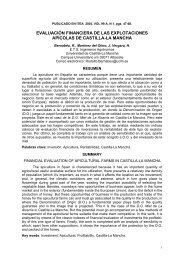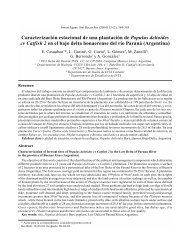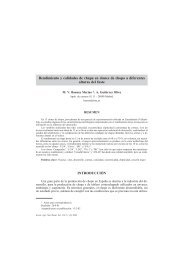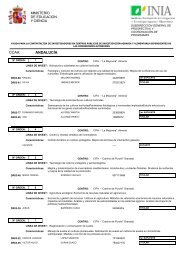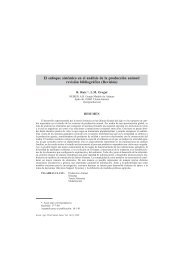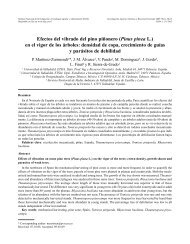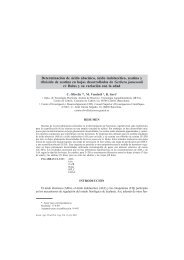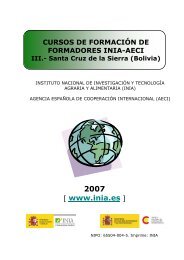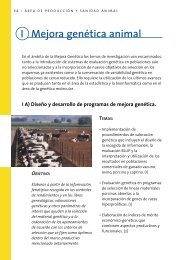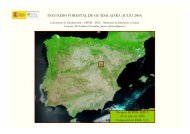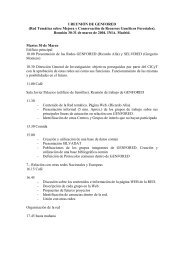Status of medicinal and aromatic plants in - Inia
Status of medicinal and aromatic plants in - Inia
Status of medicinal and aromatic plants in - Inia
Create successful ePaper yourself
Turn your PDF publications into a flip-book with our unique Google optimized e-Paper software.
PRESENTED PAPERS 93<br />
In addition to these species, there is a special product collected by the Oulu District <strong>of</strong> the<br />
F<strong>in</strong>nish 4H Association. Dur<strong>in</strong>g the last 10 years, 500-2200 kg <strong>of</strong> fresh sundew (Drosera<br />
rotundifolia) was collected from peatl<strong>and</strong>s <strong>and</strong> marketed ma<strong>in</strong>ly to Switzerl<strong>and</strong>, <strong>and</strong> partly<br />
domestically.<br />
Cultivated herbs<br />
Dur<strong>in</strong>g the last 15 years, <strong>in</strong>terest <strong>in</strong> <strong>and</strong> cultivation <strong>of</strong> herbs has <strong>in</strong>creased significantly. The<br />
acreage <strong>of</strong> herbs <strong>in</strong> 1985 was 100 ha <strong>and</strong> <strong>in</strong> 2001 it reached 3600 ha. At present about<br />
30 different herbs <strong>and</strong> <strong>medic<strong>in</strong>al</strong> <strong>plants</strong> are cultivated <strong>in</strong> F<strong>in</strong>l<strong>and</strong> to various extents.<br />
The most important herb is biannual caraway (Carum carvi), s<strong>in</strong>ce its cultivation can be<br />
easily mechanized. The area grown <strong>in</strong> l994 was 1560 ha. In 2001 it had reached 3600 ha,<br />
spread over about 350 farms.<br />
The second important spice seed is mustard (S<strong>in</strong>apis alba). At its largest, <strong>in</strong> l991, the<br />
grow<strong>in</strong>g area was about 400 ha, but due to price <strong>and</strong> quality problems its cultivation has<br />
now nearly ceased. Presently the area <strong>of</strong> mustard is barely 50 ha.<br />
The third important herb is the popular leaf dill (Anethum graveolens). In 1999 it was<br />
cultivated on 162 ha (323 farms) outdoors <strong>and</strong> on 8.2 ha <strong>in</strong>doors. Nearly all dill is used <strong>in</strong><br />
fresh form for direct sale or <strong>in</strong> the processed food <strong>in</strong>dustry. Only a few tonnes are dried <strong>in</strong><br />
F<strong>in</strong>l<strong>and</strong>.<br />
Parsley (Petrosel<strong>in</strong>um hortense) is the fourth important herb. It is cultivated outdoors <strong>and</strong><br />
<strong>in</strong>doors on a total <strong>of</strong> 20-28 ha, ma<strong>in</strong>ly for fresh consumption.<br />
Dur<strong>in</strong>g the last 4-5 years, the cultivation <strong>of</strong> garlic (Allium sativum) has <strong>in</strong>creased to 24 ha.<br />
Production is widely distributed <strong>and</strong> is carried out on small-scale plots. Nearly 170 farms<br />
are engaged <strong>in</strong> garlic cultivation.<br />
About 10 different herbs, <strong>in</strong>clud<strong>in</strong>g some <strong>medic<strong>in</strong>al</strong> <strong>plants</strong> (e.g. Cori<strong>and</strong>er, Angelica,<br />
Oreganum, Mentha sp., Ech<strong>in</strong>acea purpurea, Urtica <strong>and</strong> Artemisia dracunculus), are cultivated on<br />
an area <strong>of</strong> between 1 <strong>and</strong> 5 ha/each. These <strong>plants</strong> are produced for further process<strong>in</strong>g, for<br />
the health food <strong>in</strong>dustry or for the growers' own products. The harvested raw materials are<br />
dried, frozen or extracted.<br />
About 20 different herb <strong>and</strong> <strong>medic<strong>in</strong>al</strong> plant species (Hypericum, Hyssopus, Matricaria,<br />
Agastache, Calendula, etc.) are cultivated on less than 0.5 ha/species.<br />
Use <strong>of</strong> <strong>medic<strong>in</strong>al</strong> <strong>plants</strong> by process<strong>in</strong>g <strong>in</strong>dustries<br />
Due to the small quantities <strong>and</strong> lack <strong>of</strong> <strong>in</strong>formation, only limited data are available about the<br />
<strong>in</strong>dustrial use <strong>of</strong> herbs <strong>and</strong> <strong>medic<strong>in</strong>al</strong> <strong>plants</strong>. The data presented here were obta<strong>in</strong>ed<br />
through personal contacts.<br />
Nearly the whole caraway yield is exported from the country. Only 100-120 t <strong>of</strong> seeds are<br />
used as a spice by the domestic food <strong>in</strong>dustry companies yearly.<br />
The domestic food <strong>in</strong>dustry uses dill ma<strong>in</strong>ly <strong>in</strong> fresh forms (leaf, flower<strong>in</strong>g shoot) <strong>and</strong><br />
only a few farms produce dried dill leaf packed for retail market<strong>in</strong>g (ca. 5 ha). Experimental<br />
distillation <strong>of</strong> caraway seed oil <strong>and</strong> dill plant oil has been carried out for <strong>in</strong>dustrial use.<br />
Some m<strong>in</strong>t species (Mentha x piperita, M. x dalmatica) are cultivated, ma<strong>in</strong>ly for dry leaf<br />
production <strong>and</strong> some experiments have been started for distillation <strong>of</strong> m<strong>in</strong>t oils, ma<strong>in</strong>ly for<br />
aromatization <strong>of</strong> local herb products.<br />
Fresh leaf production <strong>of</strong> st<strong>in</strong>g<strong>in</strong>g nettle has been started from both collect<strong>in</strong>g <strong>in</strong> the wild<br />
<strong>and</strong> field cultivation for the production <strong>of</strong> special frozen food products.<br />
The wild-collected sundew (Drosera rotundifolia) is exported <strong>in</strong> fresh form for the use <strong>of</strong><br />
<strong>medic<strong>in</strong>al</strong> <strong>in</strong>dustry, ma<strong>in</strong>ly to Switzerl<strong>and</strong>, but it is also used to some extent <strong>in</strong> F<strong>in</strong>l<strong>and</strong>.<br />
Bearberry leaves (Arctostaphylos uva-ursi) are collected from the wild for further <strong>in</strong>dustrial<br />
process<strong>in</strong>g <strong>and</strong> the extract is used <strong>in</strong> the perfume <strong>in</strong>dustry abroad <strong>and</strong> <strong>in</strong> F<strong>in</strong>l<strong>and</strong>.




